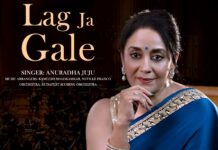By Upendra Mishra
ANDOVER, MA— Vision-Aid’s musical dance drama “Shakuntala – The Legend of the Lost Ring”, staged this past Saturday at the Collins Center for the Performing Arts, was nothing short of spectacular—a Broadway-style production that mesmerized nearly 1,000 attendees.

For me, however, it was more than just a performance; it was a deeply personal journey back into memory, myth, and meaning.
Before wandering too far down memory lane, let me first reflect on the production itself, which deserves every bit of the applause it received.
Directed and choreographed by the Indian artist Madurai R. Muralidaran, the production brought to life Kalidasa’s 4th-century BCE Sanskrit classic Abhigyan Shakuntalam with grace, grandeur, and emotional depth. This legendary tale of love, loss, and reunion was made accessible even to those unfamiliar with the original text. That is no small feat.
What Worked Brilliantly:
- Clarity of Storytelling: Despite the ancient roots of the play, the story was easy to follow—thanks to clever narration by two birds who guided the audience in English and to the well-placed English subtitles on a large screen for key dialogues.
- Costuming: The costumes were exquisite, vibrant, and period-appropriate, enhancing both the visual spectacle and the authenticity of the performance.
- Natural Acting and Expressions: The actors, almost all of whom were local dancers, delivered natural and heartfelt performances, conveying deep emotion with classical gestures and expressions.
- Musical Excellence: The music, which included a collaboration with a Hungarian orchestra, brought a unique and haunting quality to the production—melding East and West in a seamless aural tapestry.
- Community Involvement: With a cast of about 50 local dancers, and coordination led by Jeyanthi Ghatraju, this was not only a masterful artistic performance but also a testament to community collaboration and cultural pride.
 One minor critique: the background visuals on the screen, while useful, could have been improved with higher-resolution imagery. Whether the muted or live visuals were an artistic choice to keep focus on the dancers or a technical limitation is unclear. Some audience members I spoke with shared this sentiment, though it did not significantly detract from the performance.
One minor critique: the background visuals on the screen, while useful, could have been improved with higher-resolution imagery. Whether the muted or live visuals were an artistic choice to keep focus on the dancers or a technical limitation is unclear. Some audience members I spoke with shared this sentiment, though it did not significantly detract from the performance.
A Personal Reflection: From Allahabad to Andover
My own connection to Shakuntala dates back to childhood, when I first heard about Bharat, the legendary son of Shakuntala and King Dushyanta, after whom India (Bharat) is named. But my deeper immersion came during my college days at Allahabad University, where my roommate, Shiv Sagar Singh, was studying Sanskrit.
He used to narrate episodes from Abhigyan Shakuntalam with such fervor that I was compelled to read the play myself. I was captivated by Kalidasa’s poetic imagery, romantic dialogues, and the story’s spiritual undertones.
Watching Vision-Aid’s version decades later, I experienced the story differently. As a younger man, I saw the play as a tale of epic romance and divine drama. Now, with the benefit—and burden—of life experience, I found myself moved by different moments, asking different questions.

The Inner Narrative
The story begins with Sage Vishwamitra, whose powerful meditation is interrupted by Menaka, the celestial nymph sent by Indra to distract him. Their union leads to the birth of Shakuntala, a child abandoned by both parents, yet raised lovingly by Sage Kanva in the forest.
This opening struck a chord in me. How tragic and beautiful that a child unwanted by her birth parents is nurtured by nature and saints. It made me ponder the fragility of beginnings—and the unexpected sources of love and stability that can shape us.
Later, Shakuntala’s fateful love affair with King Dushyanta begins. After their Gandharva marriage, a curse by Sage Durvasa causes Dushyanta to forget her—until a lost ring swallowed by a fish is discovered and returned to him, restoring his memory.
The chain of events—a curse, a lost ring, a fish, a fisherman—feels almost absurd in its improbability. And yet, isn’t that life? A tapestry of coincidences, accidents, delays, and unexpected recoveries.
As I watched, I found myself thinking not just of Shakuntala and Dushyanta, but of all of us—how we lose each other, how memory fades, and how, sometimes, through grace or sheer luck, we find our way back.
On Human Nature and Divine Irony
When Sage Vishwamitra, despite all his spiritual power, succumbs to desire, I found myself asking: If even sages cannot resist human longing, what chance do ordinary mortals have? Perhaps Kalidasa wasn’t offering a moral lesson but an acceptance of the human condition. Desire, folly, memory, love, loss—they are not deviations from the path, but the path itself.
Maybe the sages weren’t meant to be saints as we define them today. Maybe they lived fully—without shame, without posturing—embracing the complex beauty of human emotion. That thought stayed with me throughout the performance.
A Dance Between the Ancient and the Contemporary
At its heart, Shakuntala is a tale of patience and restoration. Shakuntala doesn’t rage against her fate. Dushyanta doesn’t forget her out of cruelty—it’s a cosmic accident. Time and circumstance separate them, but love endures. The resolution is not just a happy ending—it is a return to wholeness.
In a time when we demand instant resolutions and fear uncertainty, this story reminds us that some journeys take time. And that, often, the ring returns.
Vision-Aid’s Shakuntala – The Legend of the Lost Ring was more than a performance. It was a mirror—held up to ancient India, to mythology, and to our own lives. Through dance, music, and story, it asked timeless questions about love, memory, identity, and fate.
For those unfamiliar with Kalidasa, it was an accessible introduction. For those of us who grew up with his verses, it was a rediscovery. And for me personally, it was a reunion—with a younger self, with the richness of Sanskrit drama, and with the quiet wisdom buried in old stories.
In the end, the magic of Shakuntala lies not just in what is performed on stage—but in what it awakens within us.
(Upendra Mishra is the author of After the Fall: How Owen Lost Everything and Found What Really Matters, and Precise Marketing: The Proven System for Growing Revenue in a Noisy World and the managing partner of The Mishra Group. He writes passionately about marketing, scriptures, and gardening. Learn more atwww.UpendraMishra.com.)













